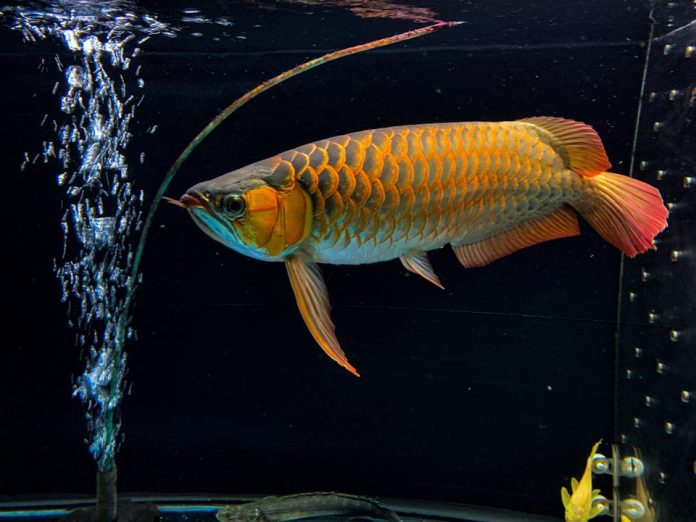Looking for the gold standard for your aquarium? Meet the Asian arowana, the unofficial Lamborghini of the sea—and the most expensive aquarium fish in the world.
These dragonfish are particularly revered in China, where the freshwater pets are status symbols—and cost a pretty penny. Back in 2009, one was rumored to have sold for $300,000. That fish was said to have commanded top dollar as a prized albino version, and other arowanas reportedly fetch tens of thousands of dollars. (The fish’s average life span is 10 to 15 years; if you want an arowana that will last a little longer, check out this arowana sculpture—made of jade, opal, and marble—selling on eBay for $5.8 million.)
That the coveted species is endangered only adds to its intrigue (some people have been arrested for smuggling them). But that’s not the most striking fact about the arowana. These fish cause such a frenzy that sometimes they have their own motorcades for transport and their own bodyguards, according to Business Insider. There’s even a market for cosmetic face-lifts for fish suffering from droopy eyelids or needing a chin tuck. An eye lift runs a weirdly affordable $90, and a chin correction costs about $60, according to The New York Times.
“[The arowana] is a very valuable commodity, and that had driven a tremendous amount of crime around the areas where it’s bred,” Emily Voigt, a journalist specializing in science and culture, told Business Insider. Voigt’s new book, The Dragon Behind the Glass, chronicles the intrigue (murder and fish kidnappings) of the arowana and its rise to fame as one of the world’s most coveted aquatic pets. Before the 20th century, these fish were nothing special. They were considered a food source for locals. It wasn’t until the late 1960s, according to Voigt, that the fish became a sought-after commodity. By the 1980s, they were firmly cemented in Asian culture as symbols of luck and wealth.
Now the prized fish are being bred to produce unique color combinations. Chili red arowanas (pictured) go for around $1,400; emerald-violet fusion super reds run about $12,000; and the rare albinos, while less striking, command six figures. The one sold in 2009 was rumored to have gone to a Chinese Communist Party official.
If all of this has you itching to buy one of these pricey flippers, you may have to settle for a different exotic pet if you live stateside. Arowanas are banned in the United States, protected by the U.S. Endangered Species Act.
THE TYPES OF AROWANA
Arowanas are freshwater, bony fish known for their slender bodies, large scales and wide variety of colors. They are highly sought by avid aquarists and collectors. Popular arowanas include the red, golden, silver, Jardini, and Leichardti arowanas.
Red Arowanas
Red arowanas are from the freshwaters of Indonesia. When they are young, they are known for their red lips and gills, but true color does not occur until the fish mature. Red arowanas are not exclusively red; they range between pink, orange, blood red and dark red. Red arowanas are thought to bring prosperity and wealth to the owner.
Golden Arowanas
Golden arowanas are from the freshwaters of Malaysia and Indonesia. They’re commonly called Malaysian golden arowanas or Malaysian “bonytongues.” They have a combination of gold and dark green scales, but from a distance, the fish look like they are completely covered in golden scales. Golden arowanas are highly sought after, but because of their poor breeding habits, they are an endangered species. Under the CITIES Convention and Fisheries Department, fisheries must ensure that each transaction of golden arowanas in Malaysia meet the CITES permit of ownership, marketing, breeding and trafficking of the fish.
Silver Arowanas
Silver arowanas are from the freshwater basins and tributaries of the Amazons in South America. As adults, they have big silver scales that have a tinge of light pink and blue on the fins; they are also much flatter than other arowanas with larger heads. In the wild, the species can grow up to 4 feet long. Silver arowanas are among the cheaper arowana to buy, but they are among the harder to keep. Silver arowanas have a hard time adjusting to frozen food; they prefer a diet of small fish and shrimp.
Jardini Arowanas
Jardini arowanas are from Northern Australia and New Guinea. They’re commonly called the Northern arowana or the pearl arowana. Hobbyist who keep Jardini arowanas do not have to be as careful about keeping a lid on the aquarium because this species are less likely to jump out of the tank. As young fish, they are mild; as they age, the fish can become semi-aggressive, making them better as solitary fish. Jardini arowanas adapt better to captivity, adjusting diet and feeding habits to pellets and frozen foods.
Leichardti Arowanas
Leichardti arowanas are from Southern Australia. They are commonly called Australian spotted arowanas and spotted barramundi. Like Jardini arowanas, fish of this species do well in captivity and have adapted to feeding on pellets and frozen foods. They tend to stay at the bottom of the aquarium, whereas other arowanas tend to stay at the surface of the tank. Leichardti arowanas are not popular aquarium fish.





























